Brief Encounter - the muzungu's complete guide to Kenya's SGR 'Madaraka Express' train between Nairobi and Mombasa
Ah, the romance of train journeys!
My love affair with trains started as a child when my Mum and I would take an occasional train journey to London. As the train pulled into the stately St Pancras station, passengers would pull down windows to open the heavy doors and jump from the still-moving train onto the platform. I can still feel the reverberations of those doors slamming shut behind them. I can smell the diesel. I can hear the whistle as the train gets ready to depart.
European culture resonates with train imagery: grand architecture, long cross-country journeys, meetings with strangers. The 1945 film Brief Encounter is centred around a railway station and is regarded - in Britain at least - as one of the best romantic films of all time. It's a personal favourite, for its unspoken desires, and the dramatic tension between the two lead actors. The station's night time setting heightens the drama of this clandestine affair.
My love for the railways was rekindled in East Africa when a friend and I took the Rift Valley Railways commuter train across Kampala.
However, the romance was to be short-lived: the first stop was the abattoir. Sadly, this Rift Valley Railways train is already out of service. (How? Why? Grrrr!)
Nonetheless, the short 20 minute journey fired my imagination and had me researching the Uganda Railway and its history. This led to a far bigger adventure: traveling from Nairobi to Mombasa on the infamous Lunatic Express - a journey many had warned me against taking. It took us an incredible 23 hours... in a heatwave no less.
Just last week, we finally got our act together to board the new SGR train, but a few questions remained:
Would the train leave on time?
Would it be as exciting as our first rail journey between Kenya's two biggest cities?
Would it have the same sense of history?
Would I be able to buy a cold Tusker on the train?
Would there be romance... ?
This is the muzungu's guide to taking Kenya's SGR train between Nairobi and Mombasa, based on my personal experience of the original Lunatic Express, the bus and the SGR train. Branded 'the Madaraka Express', this term still draws a blank with every Kenyan I have spoken to! I compare the new SGR train ride and the bus, describe Mombasa and Nairobi SGR stations and tell you what it is like on the train. I share tips for using the SGR train, the booking process and how to pay by M-Pesa. I also suggest a few ways the service could be developed for an even better traveling experience.
The SGR train is deemed to be a great success and has carried over 100,000 passengers since its inaugural trip on May 31st 2017. At 3,000 KES, even first class tickets represent good value for money (and are certainly cheaper than flying). We opt for second class tickets, which are cheaper than bus tickets, at just 700 KES each. We take the bus from Nairobi to Mombasa and the SGR train for the return leg of the trip.
Here's our story of the bus and the SGR train, and the pros and cons of each mode of transport. In summary, the train wins but the advantages are not clear cut. Here's why:
As befits railway infrastructure grands projets, Mombasa SGR station is an impressive structure. The building has been designed well to accommodate the flow of passengers. It is light and spacious.
There is high security at Mombasa SGR station. It starts with the (very inconvenient) stop before the bridge above the station. Julia persuades the police to let our tuk tuk full of baggage drive across the bridge and down the ramp, but not all train passengers are as fortunate. Many have to walk.
In a temporary-looking structure in front of the station, we dutifully place our bags in front of the sniffer dogs. I know I'm going to be asked to delete the photo, but I still risk taking one!
Next our bags are scanned and our bodies frisked. We go through this process a second time as we enter the main building. Julia is quizzed about her penknife and a glass bottle. At the entry to the main building are two security information boards but, by the time you've reached the SGR station, it's too late to act on much of the information displayed. (An advisory email or SMS would be useful).
We eye up the futuristic-looking glass elevator.
"Are you first-class people?" Asks the security operative. "Yes! Of course we are." (It's a shame we only have second-class tickets though!) The elevator goes to the first class VIP waiting area only, on the floor above ours. We take the escalator, giggling.
Security is tight. Staff don't like us taking photos and I am told off, more than once!
In the ticketing area, a large board shows the availability of trains for the coming eight days. It appears that first-class tickets are sold out quickly: all first-class tickets have been sold out for three days, and very nearly sold out for another three days. Afternoon trains are the most popular.
"Please go to the counter for real-time updates" says the sign but why not use the public address system to make life easier? It doesn't make sense to ask several hundred people to queue at the counter for updates.
There are several toilets in the building, although not enough. Our floor has a disabled toilet, and three other stalls. We find them to be clean. Ladies, there is even toilet paper!
I am gobsmacked that there is nowhere to buy anything to eat or drink at Mombasa SGR station, not even water. Neither do we see any drinking water fountain. What happens if you are taken ill? It would take you between 15 and 30 minutes to exit the station, walk up the long ramp, cross the bridge, buy water, come back the same way - and then pass back through three lots of security. If you're ill, disabled or with children, you're going to struggle. Plan ahead.
The station has hundreds of seats, but more are needed. Why isn't there any Wi-Fi? (There's none on the train either). You can't smoke in the station.
There is a prerecorded announcement to advise when it is time to board the train. The lady has a Chinese accent. We leave exactly on time: 3.15 in the afternoon. Three Chinese managers stand on the platform to watch the train pull away from the platform.
What's it like on the SGR train?
The train feels fresh and cool as we enter. It's very clean. First impressions are good.
There is a small table between each set of seats. I feel like we're travelling in a caravan.
Curtains allow you to block out the afternoon sun. Next to the window seat is a small hook for a coat or handbag.
Although we have three seats - 98, 99 and 100 - only two of the seats are next to each other. The seat numbering system is confusing.
A man and a woman push a small snacks trolley down the aisle. I fancy something to eat. Tea is 100 Kenya shillings, Tusker is 250 bob and a beef or chicken sandwich is 350. Sandwiches are fresh and tasty (although I'm not a big fan of sweet white bread).
For the first hour of our journey, the train is quiet. After a while everyone starts chatting. That's the upside of there being no WiFi.
To kill time, Julia and I tuck into some baobab fruit. Our tongues turn bright red with the food colouring. The baobab fruits looks as inviting as a fresh raspberry but are moss-covered stones that require several minutes hard sucking to release the sweetness.
Ten minutes after Voi station, Dianah calls out "Charlotte, you have missed elephants!" I'm sitting on the wrong side of the train to watch Tsavo's wildlife. Our seats look onto the 'transport corridor' - the old railway line and the road, and that's fine for now: I'm focused on comparing road and rail (the elephants can wait!)
There are regular messages to throw litter in the bin. The toilets are clean throughout the journey. Three quarters of an hour before Nairobi, a member of staff picks up the remaining rubbish. They even mop the floor!
We arrive at Nairobi SGR station five hours later, at exactly the time expected.
Nairobi SGR station is a state-of-the-art piece of infrastructure. It's easy to navigate and well lit. We cross over the railway line to take the 50 bob shuttle train to Nairobi's original railway station. SGR staff tell us it will take 20 minutes. It takes us 50 minutes. From the station, we take an Uber. It's been a long day for us: we left Watamu in a tuk tuk at 7.30 am. Next we boarded a matatu from Malindi to Mombasa before taking another tuk tuk from the centre of Mombasa to the SGR station.
Photos of the SGR stations and route: the muzungu's guide to the SGR 'Madaraka Express' train between Nairobi and Mombasa 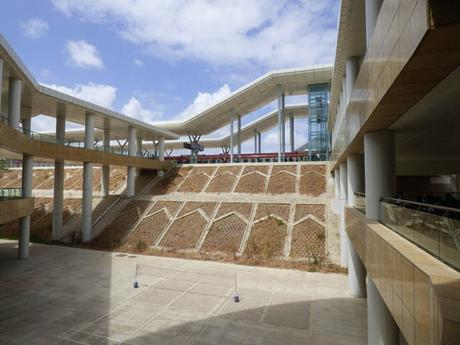
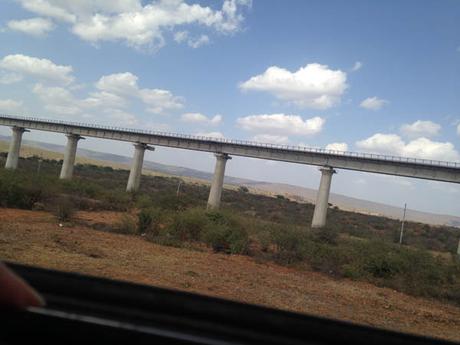
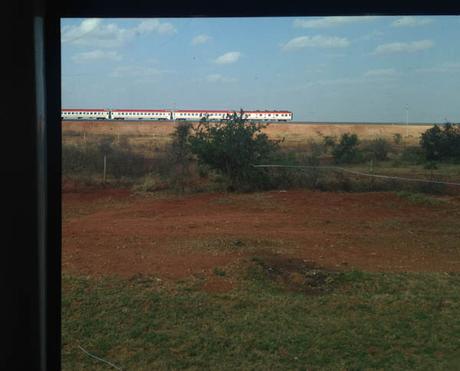

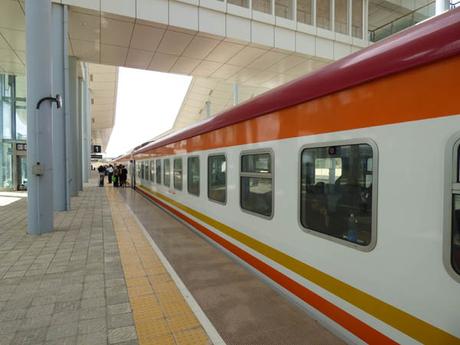
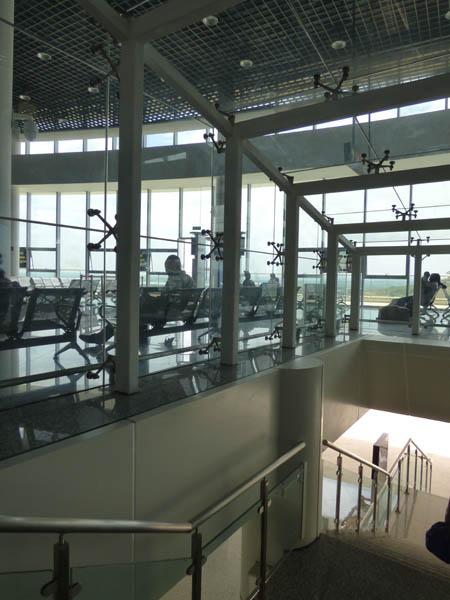
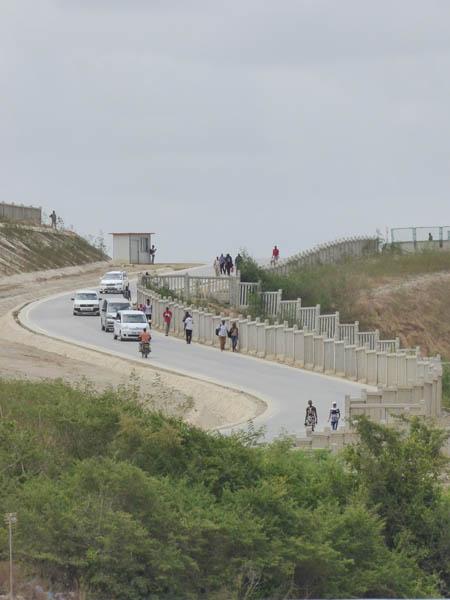
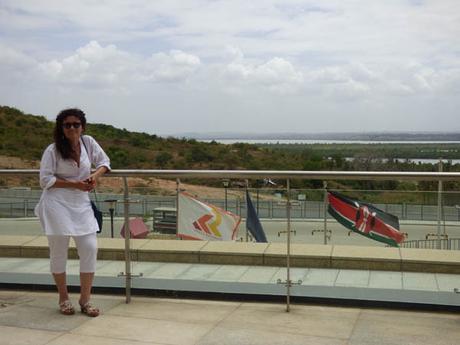
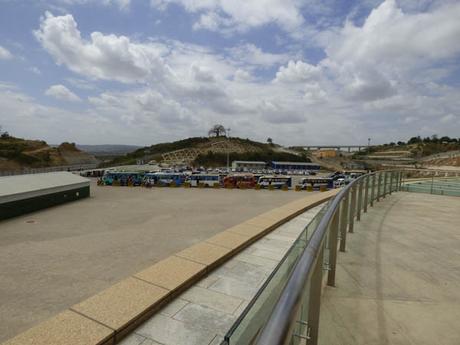
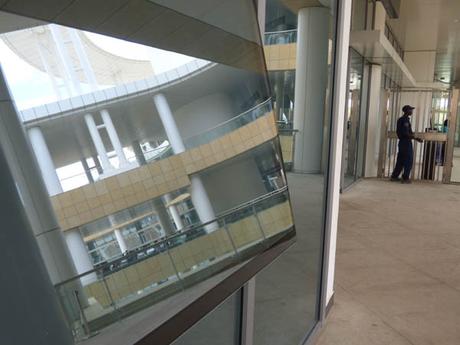

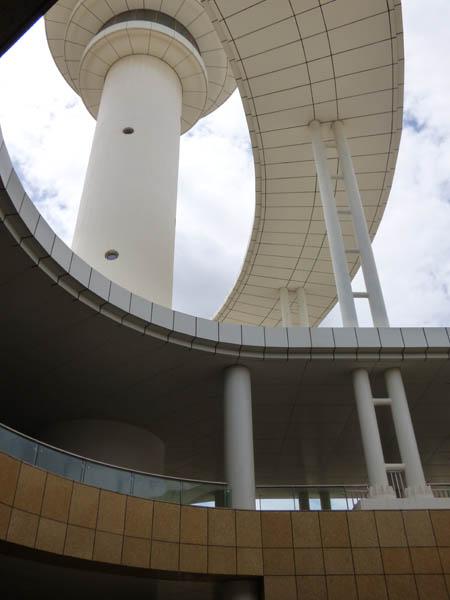
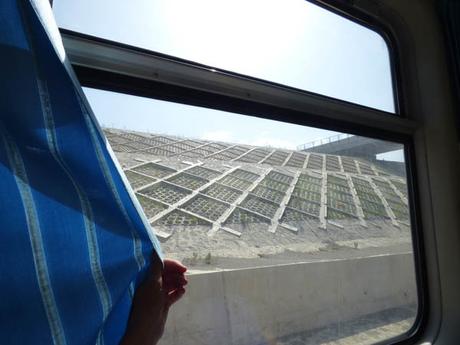
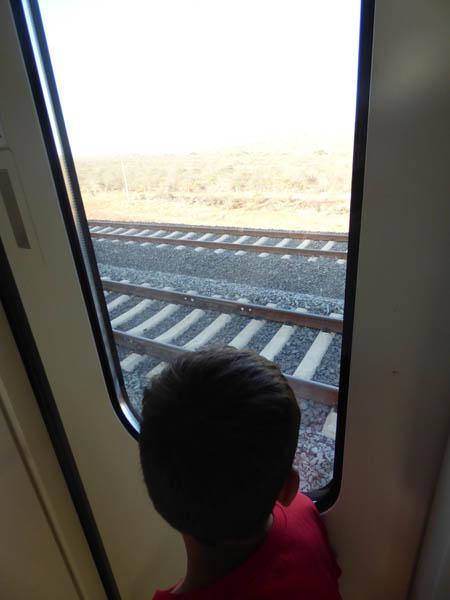
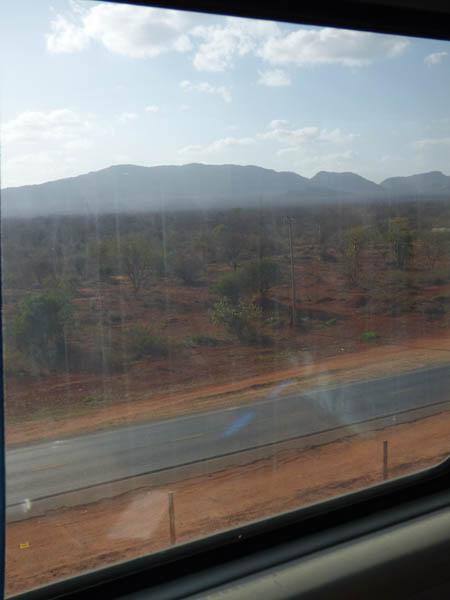
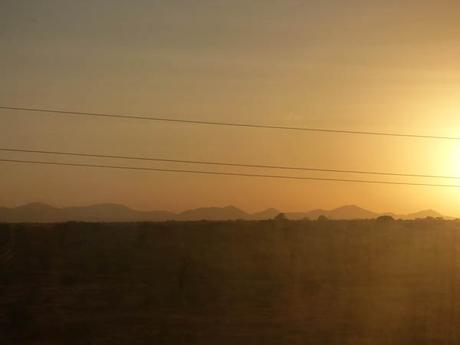
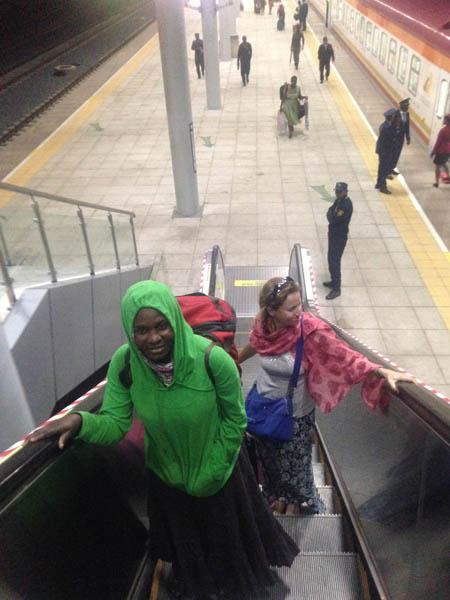
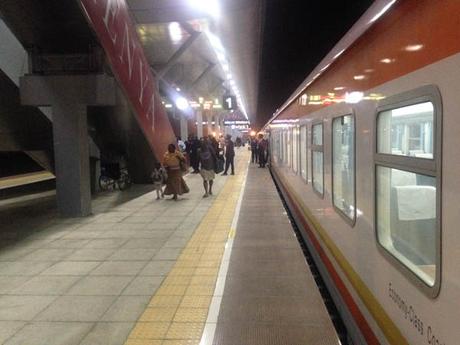
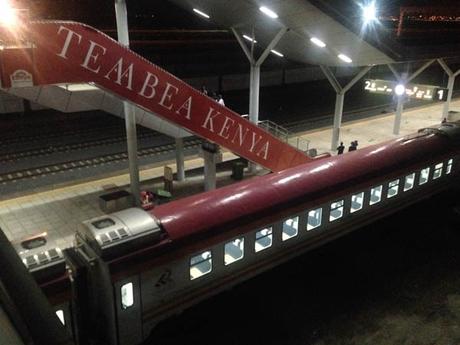
Advantages of taking the SGR train
The SGR train journey time is five hours.
The train is safe - no dodgy overtaking of container lorries.
The journey is smooth - no potholes. (No sports bra needed! Unlike traveling in a bumpy tuk tuk!)
The train is more spacious. Tall friends may prefer first-class for its legroom but second-class is fine as you can easily stand up and stretch your legs by walking between the carriages.
Travelling by train is more secure than the bus. There are numerous security checks before you get on the train - cameras in the station? The train doesn't have seat belts (neither does it have to overtake into oncoming traffic).
The train has toilets.
The train has air-conditioning. It is dust-free travel - even in the dry season.
You can drink alcohol on the train. You can also buy other drinks and snacks.
It's easier to watch birds and wildlife from the train!
Each train carriage has a dedicated member of staff. Our lady was very friendly.
The train is cheaper than the bus, if you buy a second class ticket. Ticket prices: 700 Kenya shillings ($7) standard class. First class tickets are 3,000 Ksh ($30) each. However, the actual train journey price is substantially higher since you have to factor in travel to and from the SGR stations (in remote locations outside the city centres).
As I write, there's a rumour that SGR plan to increase the prices of the tickets. Note: the web site says fares are 'promotional.'
Advantages of taking the bus
Some of us enjoy slow travel. The bus journey time is eight hours.
If you take the bus, you can get from the centre of Nairobi to the centre of Mombasa without having to change vehicle. If you have lots of bags, are travelling with children, or have mobility issues, you might prefer to simply take the bus.
You only have to buy one ticket for the whole journey, meaning less hassle. If you take the SGR, you have to allow extra time and additional cash for the connections.
Some buses have air-conditioning - but does it always work? Ditto the WiFi.
We enjoy our brief lunch stops and the chance to try the local food en route.
The bus has a few brief comfort break stops - a chance for smokers to step out.
You can choose your seats when you make your booking.
Ticket prices: Mash have seats ranging from 1,000 - 2,500 Kenya shillings ($10 to $25) according to the seat type.
Journey price = same as the ticket price. No extra costs.
Travel tips: how to book the SGR train AKA the Madaraka Express
The enquiry and booking process - online or in person
If you're going straight to the last stop, choose the express train. This runs in the afternoon. The morning inter-county trains stop at Athi River, Emali, Kibwezi, Mtito Andei, Voi, Minsenyi, Mariakani.
Book early to avoid disappointment. Learn from our mistake! (We spent 25 hours on buses from Kampala to Mombasa - with just a half hour break between journeys - because we tried to book two days before departure when the train was already sold out).
Book in person at the SGR station but it's a long way out of town. Pay by cash (only) in Kenya shillings.
Book SGR tickets online here.Use your phone. Pay by MPesa (you'll need a Safaricom Kenya SIM card to do this). Just dial *639#.
If you want to book the SGR from outside Kenya, ask your tour operator to book your tickets or contact me.
"It ought to be plain how little you gain
by getting excited and vexed.
You'll always be late for the previous train,
and always on time for the next."
― Piet Hein
Click here to see the rates for the SGR train - or Madaraka Express - on the Kenya Railways web site. Note that the fares are 'promotional fares' meaning they are likely to increase. Currently (February 2018) fares are 700 KSh standard class and 3,000 KSh first class. The web site also details fares between intermediate stations along the route.
If you want to choose your seats (sit next to a friend or be by the window facing in the right direction) book in person at the station.
To make a booking or enquiry call + 254 (0)709 388888 / 0709907000 / 0728603581/2 or email [email protected]
Print your tickets at the station.
You can book up to 30 days in advance.
The SGR station in Mombasa is in Miritini
To avoid Mombasa traffic, get on at the Mariakani stop. To do this you will need to get the slow (morning) train.
Three of us paid 700 KES for a tuk tuk from Fort Jesus to the SGR station. We had been quoted 1500 for a car.
Leave enough time to walk for 15 minutes before entering the station.
Trains depart from Mombasa twice daily. The morning inter-county train departs at 7:15 AM (arrives Nairobi 13.05) and the afternoon express train leaves at 3:15 PM (and arrives Nairobi 20.14). Tickets are on sale between 5:40 AM and 4 PM. Tickets can be purchased up to ten minutes before departure.
At Mombasa SGR there is a wide range of taxis, buses and matatus. No need to book.
The SGR station in Nairobi is in Syokimau, past the airport
Trains depart from Nairobi twice daily. The morning inter-county train departs at 8 AM (arrives Mombasa 13.55) and the afternoon express train leaves at 14.30 (and arrives Nairobi 19.20).
To get from central Nairobi to the SGR station, board the commuter train at Nairobi railway station. The fare is 50 bob between the two stations.
Would I recommend taking the SGR train?
I commend SGR for operating a reliable and affordable service. The infrastructure is excellent and the booking process easy but there needs to be more attention to the overall experience. Efficiency and cleanliness are important but the stations need water fountains, catering outlets and shops. (Not only is this useful for the passenger but it represents additional revenue streams for SGR - surely a no-brainer). SGR need to make Wi-Fi available at stations and on the train.
I had to hotspot from my Ugandan phone to order our Uber.
"If I ran the railway"... I'd display information about the SGR project and its construction. Where is the history of the Uganda Railway? Where is the tourist information? Why not play some background music? Part of the travel experience is buying and reading a newspaper, finding something tasty to eat, learning something about the route and the destination, sharing photos and updates with friends online. People don't only judge things by cost.
But was it exciting?
Did it live up to the hype?
Was there romance?
The boring issues of cost and logistics to one side, did the muzungu find the experience to be exciting?
Well yes, the novelty of the new experience made it worth the wait.
I can't say the journey was romantic - unlike the Lunatic Express was. Everything about the SGR is too shiny and corporate.
For romantic interest, next time maybe I'll just take a good book (or download a copy of Brief Encounter and daydream I'm there, underneath the clock, waiting ...)
Have you been on the SGR Train yet? How was it for you? Do tell.
If you enjoy train travel stories, my Lunatic Express story was an epic adventure.
For another view of the Madaraka Express, read The two faces of a SGR train journey to Mombasa written by East Africa tourism expert Prof. Dr. Wolfgang Thome.
Ugandan blogger Beewol (Bernard Ewalu Olupot)'s love hate relationship with trains had me in stitches. Read his article about Uganda's SGR construction Waiting on the train ...
We can't wait for the day when we can catch the SGR train from Kampala to the coast for the week-end!
" The day my suitcase got upgraded to business class
Related posts


